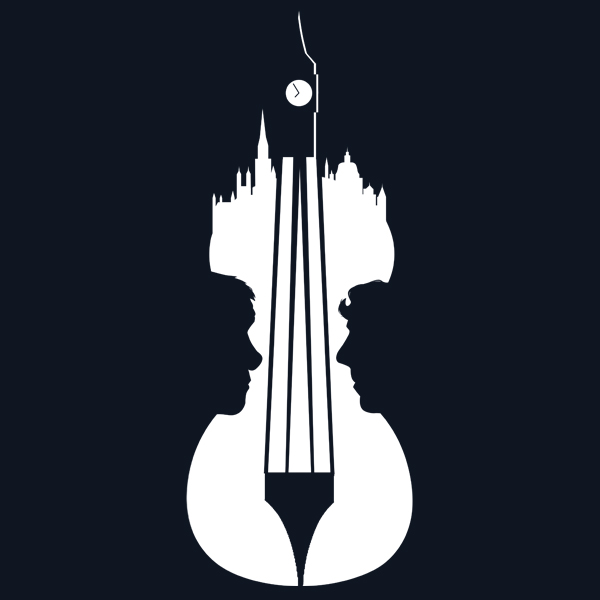Welcome to our forum. A Message To Our New and Prospective Members . Check out our Forum Rules. Lets keep this forum an enjoyable place to visit.
Currently working on errors from the latest (SimplePress) forum update. Many issues have been resoled and others are being worked on. Thank you for your patience.
 Topic RSS
Topic RSS



 (11 votes)
(11 votes) Regulars
 Offline
Offline





Regulars
 Offline
Offline








***EDITED
@Gordon Shumway -
That video of "Indifference" is so long because he shows playing it on the violin at different tempos (starting the fastest) - and also the piano accompaniment is played separately (with rolling Violin score) at different tempos for you to use.
Pick the section that has the tempo you want to play at.
It's all listed in the video description - where each starts.
I wouldn't play it at 200 BPM, but it's GREAT for learning the piece. 🤣
...think I like 120 bpm - starts at 39:05.
***Actually, "La Valse d'Amélie", by Yann Tiersen is a MUCH better example of what's been discussed in this thread! Played by Marie Leloup.

- Emily
Regulars
 Offline
Offline





There are two Wohlfahrt studies you should look at.
Op.45 n.20 and Op.74 n.34
Different notes, same rhythm, same idea, clearly.
Op 74 is intended to be easier than Op 45 - it's a later rewrite, I guess.
Notes and rhythm should be very familiar to everyone. I have no idea if Wohlfahrt inspired or was inspired by the Valse Musette. I assume the latter.
I like this first teacher normally, but he loses the rhythm badly at times: -
https://www.youtube.com/watch?.....Dxakh7vIGM
The second teacher also loses it, although he attempts to cheat: -
The key is to stress the first and third beat of every bar. Cutting the long notes short inreases the danger of it sounding like 6/8 instead of 3/4, and playing it fast is obviously trickier than playing it slowly.
It looks like I can only post one youtube link per posting.
Andrew
Verified human - the ignominy!
Regulars
 Offline
Offline









@Gordon Shumway -
Well, looks like you and I are the only ones interested in this!
I see what you're getting at - really like both of those etudes.
I'll be starting with these, slower ones, thank you. (lol)
SLOW PRACTICE - Wohlfahrt Op.45 Etude No. 20
Wohlfahrt Op 74 no 34 - SLOW with Accompaniment
As far as pinning down the French haunting sound, I'm still not sure if some specific scales or modes add to the mood or if some dissonance is responsible.
There are quite a few accidentals in those 2 etudes - haven't had a chance to analyze if there's a pattern, or some motif that has something in common with the other music in this thread.

...still haven't had a chance to write a decent note to the accordion guy, yet.
I want to word my questions carefully, but Christmas cards have gotten in the way. (lol)
- Emily
Regulars
 Offline
Offline





chromaticism...I don't know enough about music theory to know how it treats that
I've blundered here. It's important to realise that "music theory" (i.e. Western classical music theory) is a very limited animal. It only analyses the 12-tone harmonies our ET keyboards generate. Other instruments, such as African ouds, Spanish guitars and French accordions, generate voice-led(?) harmonies that simply aren't dealt with by "music theory".
Ugh, some kind of forum bug - an intervening post accidentally got deleted.
I had said that the accidentals are because #20 involves modulating between the keys of Bb, Gm and D7 with chromaticism as well, which is part of the bal-musette sound (as we agreed, possibly from the keyboard of a squeezebox).
Andrew
Verified human - the ignominy!
Regulars
 Offline
Offline








@wtw -
Even if you don't chose to read music notation, I found some video play-along arrangements of Yann Tiersen music, by Irene Urgell!
💖 "La Valse d'Amélie" (Duet) - one of my favorites, so making this a priority!
Another one I absolutely 💖 - "L'homme aux bras ballants"!
A few more Yann Tiersen play-along videos, arranged by Irene Urgell, here:
Irene Urgell - Yann Tiersen Arrangements

- Emily
Regulars
 Offline
Offline








Okay, ALL YOU VIOLISTS!
If you are like me, start working on more complicated Autumn & Winter pieces EARLY, otherwise I don't think about them until it's too late to learn them properly!
I found a great play-along video FOR VIOLA, in Alto Clef - by the French Composer, Camille Saint-Saëns.
Probably his most hauntingly beautiful composition, "Danse Macabre" (Developing Virtuosity)!

Great article about "La Danse Macabre", in general and it's history, at rapsodyinwords.com - here:
https://rhapsodyinwords.com/20.....e-macabre/
- Emily
Regulars
 Offline
Offline








Wanted to share some music by a couple of French Composers that have produced works for strings that may not be exactly haunting... more like - deliciously strange. 🤗
Christian Lauba (aka. Jean Matitia)
"MORPHING" string quartet nº2 - by Christian LAUBA played by the CASALS Quartet.
"KWINTUS" for violin - by Christian Lauba, live version by Matthew Trusler.
André Caplet died back in 1925 - he worked closely with Claude DeBussy, but also did great compositions of his own.
"Conte fantastique" for Harp & String Quartet - was based on Edgar Allan Poeʼs "Masque of the Red Death".
"Epiphanie" is a tone poem for Cello & Orchestra with 3 parts - Xavier Phillips is the Cellist for this.

...been trying to get into Halloween mode early!
- Emily
Regulars
 Offline
Offline








Last April at Fiddle Hell, I took a workshop with Jay Ungar and Molly Mason on "Capturing Emotions & Mood" in music... the subject of French Café/Musette came up & I asked what they thought gave it it's special feel, if it was a specific chord progression. Jay said "the wine"😁 - in all fairness, they really didn't have much time to ponder, so "changing baselines with simple melody & diminished chords" was all I got out of that... still pretty sure it's something more.
I was particularly interested in this video sheet music , because of the chords. At quick glance, I just notice Minor and 7th chords - so, really need to compare this to some other pieces.
In Post 20 (1st page), I shared Maurice Maurer's VIOLIN Video Tutorial for "Indifférence".
Tony Muréna was an Italian-born French accordionist/composer & Joseph Colombo was an Italian accordionist/composer - together, they composed "Indifférence", Waltz Musette.

Regulars
 Offline
Offline








François de Roubaix was a French film score composer during the 60's & 70's. In a decade, he created a musical style with new sounds, until his accidental death at 36. (wiki)
According to Wikipedia, he had no formal music training! As a teenager, taught himself jazz and trombone - even formed a band. His Father Paul de Roubaix was an Oscar-winning filmmaker and let Francois try his hand at composing a short film score. He went on to be prolific during his short time before a diving accident.
He's known for experimenting with synthesizers and early drum machines.
Francois scored a French Noir called "Le Samourai" (1967). One of the tracks, "Hotel Sandwich", caught me with the same feeling as others in this thread.
Regulars
 Offline
Offline








We've talked about "Bal-musette" earlier - thought I'd take a minute to look closer & found chords for "Tradtionell Musette"!
It's NOT haunting in any way - WAY too merry & sounds like what I envision Maurice Chevalier would be singing/dancing to while strolling through Paris. (lol)
Chords for French Accordion - "Traditionell Musette" Great audio with a choice of simple or advanced guitar & piano chords - even chords for ukulele & mandolin!
It's crazy what I found! ...said the song Key is A# but was only showing flats - gave the option to switch (seems should've been default). Didn't expect a bunch of Major AND Minor chords, only like 1 half-diminished & an augmented, only a couple 7ths - and at least 1 major & minor 6th!
So much for Musettes being riddled with diminished chords. 🙄
Except... (just saw down at the bottom of the page), they also show chords for other related tunes - valse musettes, even from Yann Tiersen! So, checked over Chords for "La Valse d'Amélie Poulain" - Yann Tiersen Accordéon. Now I'm finding quite a few half-diminished 7 chords! Might need to sign up to get better info.
Too busy to look closer or check out more today (want to study the chord progressions), but I'll get to them - would've never seen that if I hadn't posted this (had this bookmarked for a while now)!!! I had briefly looked at this site for a couple other tunes - but was quite a while ago.
ChordU.com seems like it's going to be a fun site!
🤔... half-diminished chords.
Regulars
 Offline
Offline









I've been workin' on another goodie!
Meet my new friend - "Misère" by Faut qu'ça guinche!
Check out the great fiddle breaks at 01:30 & 02:57!!!
Maybe more quirky than haunting - FUN, nice little challenge... still working on memorizing the 1st break, but I've got the 2nd one down!
Faut qu'ça guinche has an outstanding Fiddler & very eclectic repertoire - influenced by Rock, Gypsy, Classical to Punk!
A little Brahms in France?

- Emily


 Log In
Log In Register
Register
























